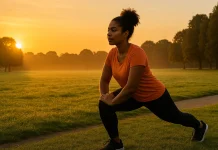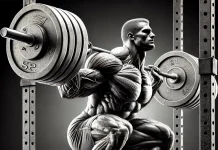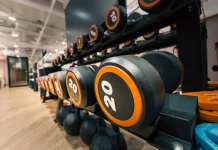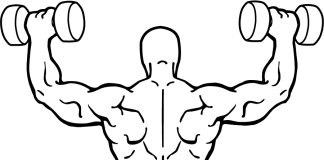Last Updated on November 2, 2024
The Narrow Stance Leg Press is a powerful lower-body exercise that effectively targets the quadriceps, hamstrings, and glutes with an emphasis on the outer muscles of the legs. By adjusting your foot position and bringing your feet closer together, you can shift the focus to the outer quads, creating a more defined and balanced leg shape. This variation is ideal for lifters looking to add variety to their leg training, prevent muscle imbalances, and build impressive leg strength and aesthetics.
In this comprehensive guide, we’ll explore the benefits of the narrow stance leg press, provide detailed step-by-step instructions, discuss common mistakes, share variations, and offer tips on how to incorporate it into your workout for maximum results. Whether you’re a beginner or a seasoned athlete, mastering the narrow stance leg press can significantly enhance your leg day routine and help you achieve your fitness goals.
Why the Narrow Stance Leg Press is Effective
The narrow stance leg press places your feet closer together, which changes the way your leg muscles are activated during the exercise. Here’s why this variation is effective:
- Targets Outer Quadriceps: By bringing your feet closer together, you shift more of the load onto the outer portion of the quadriceps, specifically the vastus lateralis. This can help create a more sculpted, balanced appearance in the legs.
- Improves Leg Shape and Definition: Emphasizing the outer quads, this variation can enhance the “sweep” of the thigh, contributing to a well-rounded and aesthetic leg shape.
- Reduces Strain on Knees and Lower Back: Compared to other squat-based movements, the leg press provides back support, reducing stress on the spine while allowing a deep range of motion without excessive pressure on the knees.
- Isolation of Lower Body Muscles: The narrow stance leg press isolates the quads and glutes while minimizing upper body involvement, allowing you to focus solely on the lower body.
Muscles Targeted in the Narrow Stance Leg Press
This exercise primarily works the following muscle groups:
- Quadriceps (Quads): The main muscle group activated, with emphasis on the vastus lateralis, or outer quad, which contributes to leg size and definition.
- Glutes: The glute muscles are engaged to support the movement, especially in the lower portion of the press.
- Hamstrings: The back of the thighs assist in stabilizing and controlling the movement, helping balance out lower body strength.
- Calves: Although not the main focus, the calves contribute to stability as you press the weight.
Step-by-Step Guide to Performing the Narrow Stance Leg Press
Step 1: Set Up Your Position
- Adjust the Seat: Sit on the leg press machine and adjust the backrest so that your hips are fully supported. Make sure the seat allows you to bring your knees close to your chest without straining your lower back.
- Position Your Feet: Place your feet on the platform about 6 inches apart (roughly hip-width or closer), with your toes slightly turned outward. This narrow stance places emphasis on the outer quads.
Step 2: Prepare to Lift
- Grasp the Handles: Hold the handles on the side of the seat for stability. Engage your core by pulling your belly button toward your spine to support your lower back.
- Release the Locks: Carefully release the safety locks on the machine, keeping your legs extended but with a slight bend in the knees to avoid locking them.
Step 3: Lower the Weight
- Bend Your Knees and Lower the Platform: Begin the movement by bending your knees, lowering the platform toward your chest in a slow and controlled motion. Focus on keeping your knees aligned with your toes to prevent inward or outward drift.
- Go as Low as Comfortable: Lower the weight until your thighs are close to your chest, or as far as your flexibility allows without rounding your lower back or causing discomfort. Ideally, aim for about a 90-degree bend in the knees.
Step 4: Hold and Press Back Up
- Pause at the Bottom: Once you’ve reached the lowest point, pause briefly to maximize tension in the muscles. This momentary hold increases muscle activation.
- Press Through Your Heels: Push the platform back up by pressing through your heels and extending your knees. Avoid using momentum; instead, focus on a controlled ascent.
- Do Not Lock Out at the Top: Stop just before your knees are fully extended, keeping a slight bend to maintain tension in the quads and avoid straining the joints.
Repeat for the desired number of repetitions, focusing on slow, controlled movements throughout.
Tips for Perfecting Your Form
Form is crucial to getting the most out of the narrow stance leg press while reducing injury risk. Here are some tips to keep in mind:
- Keep Your Core Engaged: Maintain a strong core throughout the movement to support your spine and reduce the risk of lower back strain.
- Avoid Locking Out: At the top of each rep, avoid fully extending your knees to prevent unnecessary joint strain. A slight bend keeps tension on the muscles.
- Focus on the Heels: Press through your heels rather than your toes to engage the quads and glutes effectively and reduce knee strain.
- Control the Movement: Avoid rushing through the reps. A slow and controlled descent and ascent maximize muscle activation and ensure proper form.
Common Mistakes and How to Avoid Them
Avoiding common errors can help you perform the narrow stance leg press safely and effectively:
- Rounding the Lower Back: Keep your back flat against the seat to prevent lower back strain. Adjust the seat position if you find your back rounding at the bottom.
- Using Too Much Weight: It’s tempting to load up the leg press, but using excessive weight can compromise form. Start with a moderate load to focus on technique, then increase as you build strength.
- Locking Out the Knees: Locking your knees at the top of each rep shifts stress onto the joints instead of the muscles. Always maintain a slight bend in the knees.
- Allowing Knees to Cave Inward: Ensure your knees stay aligned with your toes throughout the movement. Caving inward can lead to knee strain and reduce muscle activation.
Variations of the Narrow Stance Leg Press
Adding variety to your leg press routine can challenge your muscles differently and enhance leg development. Here are some effective variations:
1. Single-Leg Narrow Stance Leg Press
Perform the exercise one leg at a time. This variation improves balance, corrects muscle imbalances, and allows you to focus on each leg independently. It’s an excellent option for isolating each quad.
2. Narrow Stance Leg Press with Pause
Add a 2-3 second pause at the bottom of each rep to increase time under tension. This variation intensifies the workout by forcing your muscles to work harder and enhances mind-muscle connection.
3. Reverse Narrow Stance Leg Press
Position yourself backward on the leg press machine, pressing with the balls of your feet. This places more emphasis on the glutes and hamstrings while still activating the quads.
4. Low Foot Placement Leg Press
Place your feet lower on the platform, while keeping them close together. This adjustment increases the workload on the quadriceps, particularly the vastus lateralis, further sculpting the outer thigh.
5. Wide Stance Leg Press for Comparison
Perform the leg press with a wide stance to target the inner thighs and adductors. Alternating between wide and narrow stances can create balanced development in the legs and help prevent muscle imbalances.
Sample Leg Workout Including the Narrow Stance Leg Press
Incorporate the narrow stance leg press into a comprehensive leg workout to maximize lower body strength and size. Here’s a sample routine:
- Warm-Up: 5-10 minutes of light cardio and dynamic stretching, focusing on the hips, knees, and ankles.
- Squats: 4 sets of 8-10 reps to build overall leg strength and activate the glutes and quads.
- Narrow Stance Leg Press: 3 sets of 10-12 reps, focusing on controlled movement and outer quad engagement.
- Lunges (Dumbbell or Barbell): 3 sets of 12 reps per leg to target quads, glutes, and stabilizer muscles.
- Leg Extensions: 3 sets of 12-15 reps to isolate the quads and add finishing touches to leg definition.
- Hamstring Curls: 3 sets of 12-15 reps for balanced leg development, targeting the back of the thighs.
- Calf Raises (Machine or Bodyweight): 4 sets of 15-20 reps to strengthen the calves.
- Cool Down: Light stretching, focusing on the quads, hamstrings, glutes, and calves.
Safety Tips for the Narrow Stance Leg Press
Because the narrow stance leg press involves significant lower body weight, safety and proper form are essential:
- Choose an Appropriate Weight: Start with a moderate weight that allows you to complete reps with good form. Overloading can lead to poor technique and increase injury risk.
- Keep a Firm Grip on the Handles: Holding the handles ensures stability and prevents shifting, especially during heavy sets.
- Avoid Overextending the Knees: Never lock out your knees at the top. A slight bend keeps your muscles engaged and protects the joints.
- Breathe Properly: Inhale as you lower the weight toward your chest, and exhale as you press it back up. Controlled breathing not only helps stabilize your core but also reduces tension and helps you maintain a steady rhythm.
- Warm-Up Thoroughly: Prioritize warming up your legs and joints before performing heavy leg presses. Dynamic stretching, light cardio, or even a few bodyweight squats can activate the muscles and improve blood flow, preparing them for the workload.
- Keep Feet Firmly on the Platform: Ensure that both heels and toes remain in contact with the platform throughout the movement. Lifting the heels or shifting weight to the toes can strain the knees and reduce control over the movement.
- Don’t Rush the Movement: Take your time with each repetition. Rushing through the exercise can lead to improper form, reduce muscle activation, and increase the risk of injury. A slow, controlled pace maximizes the effectiveness of the exercise.
Progressive Overload Techniques
To see consistent progress and maximize the benefits of the narrow stance leg press, apply progressive overload by:
- Increasing Weight Gradually: Begin with a weight that allows you to complete all sets with good form, then increase it gradually. Small, incremental weight increases will help build strength over time without compromising technique.
- Adding Repetitions: If you’re comfortable with your current weight, try adding extra reps to each set. For instance, if you’re performing 10 reps per set, work toward 12-15 reps before increasing the weight.
- Increasing Sets: Add an additional set if you find that you’re completing your usual sets comfortably. Increasing sets can intensify the workout and further challenge your muscles.
- Incorporating Tempo Variations: Slow down the lowering (eccentric) phase of the movement, taking 3-5 seconds to lower the weight. Increasing time under tension promotes muscle growth and strength.
- Adding a Pause at the Bottom: Pause for 1-2 seconds at the bottom of the movement to hold the weight when your knees are bent. This pause increases muscle activation and builds endurance.
Integrating the Narrow Stance Leg Press into Different Workouts
The narrow stance leg press is versatile and can be used in various workout splits:
- Leg Day: Include it as a primary or secondary exercise, especially after compound movements like squats.
- Lower Body Focus: Combine it with other lower body exercises such as lunges, deadlifts, and calf raises for a balanced lower body routine.
- Strength and Hypertrophy Split: Incorporate it on days focused on hypertrophy to target the quads with higher reps and controlled movements.
- Full-Body Routine: Use it as one of your main lower body movements in a full-body workout, particularly if you’re focusing on leg development.
Tracking Your Progress
Tracking progress over time helps you stay motivated and see measurable gains. Here are some key aspects to record:
- Reps and Sets: Document the number of repetitions and sets completed for each session. Increasing reps over time shows improvements in endurance and strength.
- Weight Used: Track the weight you’re lifting. Small, steady increases indicate strength progression.
- Range of Motion: Pay attention to how deep you’re able to go with each rep without discomfort. Greater flexibility and depth indicate improved lower body mobility.
- Form and Control: Note any form adjustments and improvements in control. Tracking this information can help you refine technique and avoid common mistakes.
Frequently Asked Questions (FAQs)
1. Is the narrow stance leg press better than a wide stance leg press?
- Both variations are effective but target different areas. A narrow stance emphasizes the outer quads, while a wide stance targets the inner thighs and adductors. Alternating between these stances can lead to balanced leg development.
2. How often should I perform the narrow stance leg press?
- Including it once a week in a leg-focused workout or lower-body day is sufficient for most people. Frequency can vary depending on your goals, but avoid overloading the leg muscles without adequate recovery.
3. Can beginners perform the narrow stance leg press?
- Yes, but beginners should start with a lighter weight and focus on form and technique. Once they feel comfortable, they can gradually increase the weight and intensity.
4. What if I experience knee discomfort during the narrow stance leg press?
- If you experience knee pain, check your form to ensure your knees align with your toes throughout the movement. Reducing the weight and ensuring you’re pressing through your heels can also help. If pain persists, consider consulting a fitness professional or healthcare provider.
5. Should I avoid locking my knees entirely?
- Yes, avoid locking your knees at the top to keep tension on the muscles and protect your joints. Always keep a slight bend at the top of each rep.
Final Thoughts
The Narrow Stance Leg Press is an excellent exercise for building strength, shape, and definition in the legs, particularly the quadriceps. By narrowing your stance, you shift the focus to the outer quads, adding balance and aesthetic appeal to your leg training. When performed with proper form and gradually increased resistance, this exercise can significantly enhance lower body development.
By focusing on form, using progressive overload, and incorporating the narrow stance leg press into a well-rounded lower body or leg workout, you’ll build stronger, more sculpted legs over time. Remember to prioritize control, avoid rushing the movement, and listen to your body’s signals. With consistent practice and dedication, the Narrow Stance Leg Press can become a key exercise in your leg routine, helping you reach your fitness goals with stronger, balanced, and defined legs.





